The Role of Talcum Powder in Hair Care Practices


Intro
Talcum powder, long a staple in the realm of personal care, has found its way into the world of hair care. Its silky texture and absorbent properties have made it a go-to product for many individuals looking to enhance their beauty regimens. But like a weathered old book on the shelf, tales of its utility don't come without a fair share of scrutiny and debate. Nowadays, it’s important to understand both the potential benefits and risks of using talcum powder in hair care routines.
The Role of Talcum Powder in Hair Care
Historically, talcum powder was introduced as a preventative measure against chafing and skin irritation. Hair care enthusiasts saw its potential quite early on and began incorporating it into their daily regimens. It became a nifty quick fix to absorb excess oil, refresh roots between washes, and add volume to limp locks. Yet, it is not merely the nostalgic charm of the past that fuels its continued appeal. Touted as an offbeat dry shampoo, it managed to snag a spot in countless cosmetics palettes.
Beauty Tips and Tricks
Skincare Routine Tips
Integrating talcum powder into your skincare routine may sound unconventional, but done right, it can provide surprising benefits. Here's how:
- Absorb Excess Oil: If you're dealing with oily skin, a light dusting of talcum powder can help absorb shine without clogging pores.
- Set Makeup: Gently patting a small amount of talcum powder over your makeup can help it last longer, especially in humid conditions.
- Prevent Chafing: For those warm days or intense workouts, a sprinkle can keep uncomfortable friction at bay.
Haircare Hacks
When it comes to hair, talcum powder serves multiple purposes:
- Dry Shampoo Substitute: When you're short on time, applying a bit of powder at the roots can soak up grease and provide instant refreshment.
- Volume Booster: Sprinkle a dash of talc at the crown of your head before styling to create that airy volume that’s often difficult to achieve.
- Anti-static Solution: Static hair can ruin an otherwise polished look. A light application of talcum powder can help tame those pesky flyaways.
Makeup Application Techniques
In the make-up realm, talcum powder can serve various purposes:
- Foundation Prep: Use talcum powder before foundation to create a smoother canvas for application. This can help control excess oil throughout the day.
- Highlighting: A mix of talcum powder and highlighter can turn it into a great tool for illuminating the cheekbones for that radiant look without breaking the bank.
“Talcum powder is not just for babies anymore. Its versatility makes it a valuable addition to any beauty arsenal.”
Product Reviews
Haircare Product Reviews
When choosing a talcum powder for hair care, options abound. Some popular choices include:
- Batiste Dry Shampoo: This powder fuses the absorbent properties of talc with scent-enhancing technology for a delightful refresh.
- Klorane Dry Shampoo: Formulated with oat milk, this one boasts a more natural ingredient list, catering to those with sensitivities.
Both products promise fresh hair without the need for a shower, making them ideal for busy lifestyles. Expediency can go a long way in personal care.
Expert Beauty Advice
Professional Makeup Artist Insights
Makeup artists often advocate for talcum powder’s role in taming shine and maintaining the integrity of make-up looks, particularly in high-humidity locations. They suggest applying a light dusting before and after makeup application, as it can provide a comforting barrier against the elements.
Hair Stylist Tips
Hairstylists often recommend experimenting with talcum powder for quick fixes between washes. A little sprinkle before styling can add texture, especially for finer hair types. However, they caution against overuse, which may lead to buildup and the need for more substantial cleansing routines.
The End
The conversation surrounding talcum powder in hair care is nuanced and layered, just like the intricacies of one’s hair regimen itself. While it offers a bevy of benefits for oil absorption and volume, it's essential to navigate its use thoughtfully, considering the safety concerns that have arisen in recent years. For beauty enthusiasts, understanding these aspects will enable them to integrate talcum powder effectively into their hair care practices, paving the way for both informed choices and spectacular results.
Understanding Talcum Powder
Talcum powder has an interesting place in the beauty industry. It serves not just as a household staple, but also has unique applications in hair care. Understanding its composition, history, and common uses is crucial for anyone looking to explore its benefits and concerns. This section will set the foundation for informed decision-making regarding the use of talcum powder in hair care routines.
Composition of Talcum Powder
Talcum powder is primarily made from talc, a mineral composed of magnesium, silicon, and oxygen. This unique mineral gives talcum powder its soft texture and strong absorbency. The granules are ultra-fine, which allows it to glide smoothly over skin and hair. Importantly, it’s the very structure of talc that allows it to absorb moisture, making it ideal for use in humid climates.
A typical talcum powder product may contain additional ingredients. But at its heart, pure talc remains the key player. There’s always a concern around contaminants like asbestos, which can be present in naturally occurring talc deposits. Users need to ensure they are choosing products that explicitly state they are asbestos-free to minimize potential health risks.


Historical Context
The history of talcum powder is steeped in rich narratives. Dating back to the late 19th century, talcum powder was initially used as a body powder. It then gained traction as a common personal care product, especially among mothers, to soothe and protect their babies' skin. Through the decades, marketing began to highlight its versatility, and salons embraced it as a styling tool.
Over time, talcum powder has been viewed through various lenses—celebrated for its beneficial qualities or criticized due to health concerns, particularly those surrounding inhalation or long-term use. This has led society to cultivate a complex relationship with talcum powder, especially in recent years, as more people have become health-conscious and aware of potential risks.
Common Uses of Talcum Powder
When it comes to applications, talcum powder is not just limited to hair but spans a myriad of uses:
- Body care: Prevents friction and absorbs moisture, common in athletic circles.
- Baby care: Historically used for diaper rashes and to keep infants dry.
- Cosmetics: Often found in foundations or setting powders to provide a matte finish.
- Hair care: Acts as a dry shampoo, enhances volume, and absorbs oil, making it a favorite for those looking to refresh their look on busy days.
Talcum powder has woven itself into various everyday practices, reinforcing its multifaceted utility. As we dive deeper into its specific relevance to hair care in the upcoming sections, it becomes clear that understanding these foundational aspects allows for an informed approach to utilizing talcum powder effectively.
"It's not just a powder; it's part of a legacy woven into our beauty routines over generations."
As we continue, we must navigate through its specific applications in hair, exploring why it’s heralded as a go-to for many and understanding the nuances surrounding its use.
Talcum Powder in Hair: The Basics
When it comes to hair care, the use of talcum powder may not be on everyone’s radar, yet it plays a significant role in achieving specific looks and managing issues that can arise. From mishaps during a hot summer day to unexpected oily roots before an important event, understanding the essentials of talcum powder can offer valuable benefits.
Why Use Talcum Powder in Hair?
There are several reasons one might consider tossing a bit of talcum powder into their hair care routine. First off, it’s a practical tool for oil control. For many, especially those with oily scalps, a light sprinkle can sweep away sebum, giving a fresher appearance without the need for a full wash. This attribute is particularly handy when you’re short on time or traveling. You might even hear someone say that talcum powder is like a "savior in a pinch."
Additionally, the lightweight nature of talcum powder helps in adding volume and texture. It can transform flat, lifeless locks into something more vibrant and full of body.
"A spritz of life for hair that feels tired and lackluster."
Finally, say goodbye to heavy products; talcum powder can serve as a natural alternative to conventional styling products. Instead of layering on gel or mousse, a dusting can create the desired grip without the sticky feeling which is often encountered with these products.
How Talcum Powder Works on Hair
At its core, talcum powder works through absorption. The fine particles soak up oil and moisture, which is why it feels so refreshing on oily hair. The method is quite simple yet effective. When applied to the scalp or roots, the powder clings to these oils and draws them away from the hair strands.
Furthermore, talcum powder creates an illusion of thickness. By applying it to the roots, you can achieve that much-coveted voluminous style. For those struggling with flat hair, a few puffs can make all the difference.
In practical terms, here’s how one might use it:
- Start with clean, dry hair.
- Section your hair and sprinkle a small amount at the roots where greasiness tends to lurk.
- Use your fingertips to rub it in gently, spreading the powder evenly.
- Style as desired.
This process not only helps with oiliness but also gives you a touchable and manageable finish, making it a versatile choice in hair care.
Benefits of Talcum Powder for Hair
The topic of talcum powder in hair care is a conversation starter amongst beauty enthusiasts and professionals alike. While many people associate talcum powder with baby care or a fresh scent, its role in hair grooming is often overlooked. The benefits it brings, from moisture absorption to enhancing volume, make it a versatile product to keep in one’s hair care arsenal. This section dives into the specific elements that contribute to its appeal in hair care routines, highlighting the advantages it can offer to anyone keen on maintaining healthy, manageable locks.
Oil Absorption
A major selling point of talcum powder in hair care is its ability to absorb excess oil. Oily hair can be a nuisance, making it appear limp and lifeless. This is where talcum powder shines. When sprinkled onto the roots, it acts almost like a sponge, soaking up oil and sebum, giving you a fresher look with minimal effort. This is particularly ideal for those busy days when washing hair is simply not on the agenda.
"Talcum powder can be a lifesaver for anyone combating oily hair. It offers quick fixes that allow for a more polished appearance without the hassle of daily cleansing."
Using talcum powder effectively can be a game changer for hair care. Notably, those with fine hair often find themselves struggling against flatness; a little sprinkling can make a world of difference. However, while talc does its job well, it’s essential to apply it sparingly. A light dusting goes a long way. If overused, it can leave a residue, making the hair look dull instead of fresh.
Volume and Texture Enhancement
When it comes to volume, talcum powder is like a magician up your sleeve. Unlike typical styling products that can weigh hair down, talcum powder can add an immediate lift. When applied to the roots, it creates separation between hair strands, infusing a sense of body and bounce.
Moreover, using talcum powder provides a unique texture that many styling sprays or gels can’t replicate. The powder gives hair a shaggy, tousled look, which is desirable for many fashion-forward individuals. Not only does it add volume, but it can also give hair an effortlessly chic style,
For anyone looking for a natural-looking lift, the key lies in application. A little dab on your roots and gently massaging it in can produce coveted results. If you're aiming for a beachy vibe or just want to avoid that weighed-down feeling that comes with some hairstyling products, talcum powder is a strategic choice.
Dry Shampoo Alternative


At some point, we’ve all faced a day where showering is either not a n option or seemingly impossible. This is where talcum powder can come to the rescue as an alternative to dry shampoo. While dry shampoos can be great, they don’t always suit everyone's needs; some products might cause irritation or not blend well with certain hair textures.
Talcum powder serves as a budget-friendly solution.
- Easy to use: Simply sprinkle on the roots, let it sit for a moment, then brush through your hair to distribute.
- Cost-effective: It generally costs less than specialized dry shampoos.
- Versatile: It can double as an oil absorber and texture enhancer, elevating your hair with minimal fuss.
In sum, talcum powder is more than just a classic staple. Its dynamic benefits in oil absorption, volume enhancement, and its role as an alternative to dry shampoo create a compelling case for its inclusion in hair care routines. For those willing to experiment, this simple powder can pave the way for effortless styling solutions!
Safety and Health Concerns
When discussing talcum powder in the context of hair care, one cannot overlook the safety and health concerns that accompany its use. Although talcum powder has been a staple in many beauty routines for decades, growing awareness of potential health risks has raised eyebrows among experts and consumers alike. It's vital for individuals to be equipped with knowledge not only about the benefits but also about the implications of using this product on their hair.
Potential Risks of Talcum Powder Use
The potential risks associated with talcum powder are multifaceted. One of the primary concerns has been the presence of asbestos in talc, which is a naturally occurring mineral. According to several studies, prolonged exposure to talc containing asbestos is linked to serious illnesses, including lung cancer and other respiratory issues. While many brands have ceased using talc that contains this harmful substance, the concern still lingers.
In addition to the asbestos issue, there are other risks tied to talcum powder's inhalation or contact with mucous membranes. Some individuals may experience skin irritation or allergies, leading to redness and discomfort. For those with sensitive skin or pre-existing conditions like eczema or psoriasis, the use of talcum powder might exacerbate these problems. It’s crucial to listen to your body and reconsider the use of talcum powder if adverse reactions occur.
The Controversy Around Talc
The controversy surrounding talcum powder largely stems from legal claims against companies that produced talc-based products. Numerous lawsuits have accused these companies of failing to adequately warn consumers about the risks associated with their products—especially concerning the alleged link to ovarian cancer when used in the genital area. This has led to a deeper investigation into the safety protocols and ingredient sourcing of talc used in cosmetics.
Despite the debates, some experts argue that using pure talc properly is relatively safe. This dichotomy makes it difficult for consumers to discern what is genuinely safe for use on their hair and scalp. Furthermore, misinformation can spread like wildfire on social media platforms, leading to fear-based reactions without substantial evidence. It's always wise to vet your sources and consult with professionals when in doubt.
Regulatory Oversight
Regulatory oversight of talcum powder products remains a significant concern. In the United States, the Food and Drug Administration (FDA) does not have the authority to review cosmetic products before they hit the market. This means that companies are free to use talc in their products without prior FDA approval, as long as they comply with labeling requirements.
However, organizations like the Cosmetic Ingredient Review (CIR) assess the safety of cosmetic ingredients and have found talc to be safe in certain formulations, provided that it is free from asbestos. In the European Union, regulations are stricter, with greater emphasis on safety testing and ingredient transparency. Consumers may want to look for products from brands that are committed to rigorous safety standards—directly referencing their ingredient sourcing and testing protocols.
In essence, understanding the regulatory landscape is crucial for beauty enthusiasts. Knowing who oversees the safety of talcum powder can empower consumers to make informed choices, whereas ignorance could lead to unforeseen consequences.
"Safety should be the primary concern; a product is only as good as its ingredients."
As the debate rages on, individuals have the responsibility to remain informed and proactive about the products they use in their hair care routines. From considering the potential risks to understanding the regulatory environment, the landscape of talcum powder is complex yet vital in guiding consumers towards making educated decisions.
Talc-Free Alternatives
As the discussion around talcum powder and its implications in hair care continues, many individuals are seeking alternatives that sidestep the harsh scrutiny placed on talc. Talc-free alternatives are not just about evading concerns but offer diverse benefits that cater to the increasing demand for safer and natural personal care products. Choosing products without talc can be a positive move for those prioritizing health, sustainability, and efficacy in their beauty routines.
Natural Ingredients for Hair Care
When considering natural ingredients as substitutes for talcum powder in hair care, a world of options opens up. These alternatives often leverage the goodness of botanical and organic sources, ensuring that the hair remains healthy while still achieving desired results. Some natural substitutes include:
- Arrowroot Powder: This fine powder works wonders for oil absorption and can help add volume to limp strands.
- Cornstarch: Widely used in DIY dry shampoos, cornstarch effectively absorbs excess oil and gives hair a fresh appearance.
- Rice Flour: Known for its texture-enhancing properties, rice flour can add body to hair while acting as a natural deodorizer.
- Baking Soda: Although used primarily for baking, a sprinkle can help in oil absorption and leave hair feeling light and airy. However, it should be used sparingly, as it may alter the hair's pH balance.
These natural alternatives often come with added bonuses; many incorporate additional nutrients that can help nourish the scalp and improve hair health.
"Using natural ingredients not only ensures safety but can also contribute to overall hair vitality, creating a balance between beauty and self-care."
Commercial Talc-Free Products
The market is seeing a robust rise in commercial talc-free products aimed at catering to modern consumers' preferences. These products usually integrate a blend of naturally derived ingredients that can mirror the multifunctionality of traditional talcum powders. Some notable commercial options include:
- Batiste Dry Shampoo: In recent times, this dry shampoo has stood out for its ability to refresh hair without compromising on safety. The formulas are plant-based, allowing for easy application without the talc.
- Klorane Dry Shampoo with Oat Milk: This product boasts a lightweight formula, capturing the cleaning essence without leaving a heavy residue.
- Lush No Drought Dry Shampoo: A powder blend with a delightful grapefruit scent, designed to absorb oil while being completely talc-free.
- Amika Perk Up Dry Shampoo: This talc-free formula uses rice starch to effectively cleanse the scalp and hair.
These products not only represent safety and innovation but also appeal to environmentally conscious consumers. Each product aims to provide efficient solutions while keeping safety at the forefront. In a world where awareness is key, opting for talc-free alternatives can serve as a small yet significant step toward better health and wellness in hair care.
Best Practices for Using Talcum Powder in Hair
Using talcum powder in hair care can be a game-changer, but like anything, there are best practices to keep in mind to get the most out of it. Talcum powder isn't just a sprinkle-and-go type of product; when applied correctly, it can work wonders on various hair types. This section delves into the techniques and considerations required to use talcum powder effectively, ensuring you harness its benefits while avoiding potential pitfalls.
Proper Application Techniques


When it comes to applying talcum powder, technique is everything. Here are some dos and don’ts to guide you along the way:
- Start Small: Less is more. Begin with a small amount, maybe around a quarter-sized amount in your palm. You can always add more if needed. Applying too much at once can make your hair look dusty rather than fresh.
- Target the Roots: Focus on your roots when applying the powder. This area tends to be the oiliest and often needs the most absorption. Part your hair in sections and lightly sprinkle or rub the powder directly onto your scalp.
- Massage it In: Use your fingertips to work the powder into your scalp. This ensures even distribution and helps in absorbing excess oil effectively. It also stimulates blood flow to the scalp.
- Brush It Out: After massaging, take a brush to remove any excess powder. This step helps to achieve a natural look, blending it seamlessly into your hair.
"To find that ideal balance, practice makes perfect. It's worthwhile to experiment a bit; your hair will tell you what works best for it."
By honing these techniques, you’ll likely find that your hair feels fresher, fuller, and more manageable.
Frequency of Use
Determining how often to use talcum powder in your hair routine can depend on several factors, such as your hair type, lifestyle, and how oily your scalp tends to get. Here are a few considerations:
- Daily Use: For those with finer or easily oily hair, talcum powder can be used daily. Just be cautious about the amount you apply. A light sprinkle on day two or three after washing can keep your hair looking great.
- Weekly Refresh: If you wash your hair less frequently, using talcum powder once or twice a week can extend the life of your hairstyle. This way, your locks remain fresh between washes without stripping natural oils.
- Special Occasions: On days when you know your hair will face more challenges—like attending an event or engaging in outdoor activities—applying some talcum powder ahead of time can help. It provides that extra layer of protection against sweat and environmental factors.
Ultimately, the key is to listen to your hair's needs. Overusing talcum powder can lead to buildup, which isn't good for your scalp. Regularly assessing how your hair responds is wise.
By adopting these best practices for using talcum powder, you can optimize its benefits, paving the way for healthier and better-looking hair.
Expert Opinions and Recommendations
Understanding the perspective of experts brings valuable clarity to the discussion around talcum powder in hair care. Dermatologists and hair professionals are often considered the guiding lights in this realm, as they analyze the ingredients, their effects, and the best practices surrounding their usage. Their insights form a foundation for both safety considerations and effective hair care routines.
Insights from Dermatologists
When it comes to the use of talcum powder on hair, dermatologists stress the importance of skin safety first and foremost. Talcum powder is primarily known for its oil-absorbing abilities, but it’s not without its risks. Each dermatologist might emphasize that the quality of the talc determines its safety. For instance, cosmetic-grade talc that is purified often poses less risk, while industrial-grade talc may contain asbestos, a well-known carcinogen.
"Talc is not inherently dangerous, provided you use high-quality, cosmetic-grade products," explains Dr. Lewis, a dermatologist with over 20 years of experience.
Apart from safety, dermatologists draw attention to individual skin types. Those with sensitive or acne-prone scalps should tread carefully. It's recommended to perform a patch test before widespread application. Additionally, they often suggest diversified hair care regimens that combine various products, ensuring that talcum powder isn’t the only tool in one's arsenal.
Hair Care Professionals' Views
Hair care professionals offer a practical perspective on the use of talcum powder. They often appreciate its versatility as an instant volume booster or dry shampoo. Hair stylists highlight the ease of achieving that elusive lift at the roots, especially for fine hair types. According to stylist Maya, "A little sprinkle of talc gives that instant bounce, perfect for the days when you're short on time."
However, they aren’t shy about pointing out potential drawbacks. For one, improper application can lead to product buildup, which a stylist might describe as a "heavy feel" in the hair. The consensus among professionals is to use talcum powder judiciously. It’s vital to use it sparingly and to wash it out thoroughly afterwards to maintain healthy hair.
In summary, insights from experts create a nuanced picture: talcum powder can be advantageous but comes with precautions. Both dermatologists and hair care professionals advocate for informed decisions based on individual needs and skin sensitivities. Their recommendations pave the way for a safe yet effective incorporation of talcum powder into a comprehensive hair care routine.
User Experiences and Testimonials
The real-world application of talcum powder in hair care resonates through the lived experiences of users. This section emphasizes the importance of personal narratives, as they provide a unique viewpoint on the practical benefits and potential drawbacks of using talcum powder. By analyzing testimonials, enthusiasts can navigate the complexities of hair care choices while understanding how others have successfully integrated or struggled with talc in their routines. Personal experiences often shed light on the nuanced interplay between product claims and actual use, providing insight that can often be overlooked in clinical or promotional narratives.
Positive Outcomes
People who employ talcum powder in their hair care rituals have shared a variety of positive experiences that underscore its practical benefits. Many users rave about its ability to absorb excess oil, transforming greasy locks into manageable tresses. This oil-absorption quality is particularly cherished by those with finer hair types, as they report less limpness and more bounce in their hairstyles.
Some common positive outcomes shared include:
- Enhanced volume: Many users have found that sprinkling talcum powder into their roots introduces a much-appreciated lift, making hair feel fuller and more vibrant.
- Easy styling: The texture that talcum powder imparts can make styling easier. Users have noted how it allows for better grip with hair ties or clips, particularly for intricate styles.
- Convenience: Talcum powder is praised for its role in quick touch-ups. Busy individuals have found it to be a lifesaver for refreshing their look without needing a full wash and dry.
- Cost-effectiveness: For many, switching to talcum powder as a dry shampoo alternative has meant significant savings. It often costs less than specialized hair products, while delivering similar, if not superior, results.
"I didn't think a simple powder could change my hair game, but it turned out to be a game-changer during those lazy days!" - a satisfied user.
Reported Issues
Despite the reported benefits, not all user experiences with talcum powder in hair care have been positive. Some individuals have encountered various issues that deserve careful consideration. Understanding the nuances of these testimonials is crucial for making informed decisions about using talcum powder in hair routines.
Some of the reported issues include:
- Residue buildup: A significant concern among users is the potential for white residue that can linger in the hair, especially on darker shades. This issue can often lead to the need for more frequent washing, counteracting one of the main benefits of using talc.
- Scalp irritation: Some users have experienced irritation or discomfort on the scalp after using talcum powder, raising concerns about product compatibility with sensitive skin.
- Diminished effectiveness over time: A handful of users have noted that after repeated use, the initial benefits of oil absorption seemed to wane, leading to mixed feelings about long-term use.
- Inhalation risks: Some testimonials also mention concerns regarding inhaling talc particles during application, leading to caution among those who may be sensitive.
When considering utilizing talcum powder in hair care, these shared experiences serve as essential guiding posts. The lessons learned from both positive and negative outcomes can inform users on how best to integrate talcum powder into their individual routines while weighing potential concerns against personal needs and preferences.
Culmination
The exploration of talcum powder in hair care wraps up with a deeper understanding of its multifaceted role. While talcum powder has garnered attention for its utility in absorbing oil and adding texture, it also demands careful consideration of its potential risks and the ongoing debates around its safety. In many circles, the discussion about talc brings to light wider concerns about product ingredients in beauty routines and the need for awareness among consumers.
Final Thoughts on Talcum Powder in Hair
Encouraging Informed Choices
As we conclude, empowering oneself with information is key. Whether opting for talcum powder or venturing into talc-free territory, it’s essential to do your research. Seek out products labeled as talc-free or those containing natural alternatives like cornstarch or arrowroot powder. Check reviews from other beauty enthusiasts or skincare professionals to guide your decisions. Make a habit of reading ingredient labels and understanding what goes into your hair care products. The choice is ultimately yours, so equip yourself with the right knowledge to enhance your routine without compromising your health.







